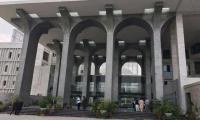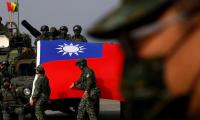listening to multiple rounds of strong arguments, a District South civil judge finally decided in favour of the police’s investigation in the case of underage marriage of purportedly Christian-turned-Muslim girl Arzoo by implicating Azhar, the man who married her, in rape and six others in facilitating the child marriage.
On Wednesday, the District South civil judge and judicial magistrate XXIII, Muhammad Ali Dall, gave verdict in favour of the charge sheet submitted by the investigation officer of the case, Inspector Shariq Ahmed Siddiqui, and ordered him to register a case under the Section 376 (punishment for rape) of the Pakistan Penal Code (PPC) read with the sections 3 and 5 of the Sindh Child Marriage Restraint Act (SCMRA).
Thirteen-year-old Arzoo had allegedly eloped with Azhar, who is said to be around 40-year-old, on October 13, after which her father Raja lodged a complaint with the Frere police station, alleging that her daughter was abducted by the accused, read the charge sheet. Later it transpired that she had married Azhar after converting to Islam.
Police had arrested Azhar’s brothers, Syed Mohsin Ali and Syed Shariq Ali, and friend Danish but later released them while nominating lawyers Mahmood Hassan and Junaid Siddiqui, who allegedly prepared marriage documents, Nikah Khawan Qazi Abdul Rasool, justice of peace Azharuddin who allegedly issued the free will certificate to the girl and two alleged witnesses of the marriage, Danish Hussain and Habib, as co-accused.
The main suspect remained absconding until the police arrested him and recovered the girl on the orders of the Sindh High Court.
Challenging the charge sheet, Azhar’s counsel Nizar Tanoli argued that the matter should be dealt in accordance with the Islamic laws as, according to the religious history, Hazrat Ali and Hazrat Zaid Bin Haris had also embraced Islam before attaining the age of 18 years. He said, “As per the Islamic law, a lady who has attained puberty could validly contract marriage and such reference can also be gathered from the life of Holy Prophet (peace be upon him).”
He said that the police was following the SCMRA in the case which had been promulgated to deter parents from illegally marrying off their children to settle tribal disputes.
Azhar’s lawyer further argued that the Section 375(v) (a man is said to commit rape who has sexual intercourse with a woman with or without her consent if she is under the age of 16) of the PPC was applicable only where the age of the victim was below 14 years and as per a medical report, the girl was more than 14 years old, due to which that section was not applicable to the case.
Raja’s attorneys Jibran Nasir and Asghar Narejo argued that the question of voluntarily or forced conversion to Islam was nowhere mentioned in the Sindh Child Marriage Restraint Act. They maintained that the age of the victim was below 16 years and therefore the Section 375(v) of the PPC was very much applicable to this matter in the light of the amendment of 2006.
The lawyers added that the victim in her second statement under the Section 161 of the Code of Criminal Procedure (CrPC) had categorically stated the name of Hassan and Siddiqui as one the facilitators of her marriage with the accused.
They said that Danish and Habib were witnesses of the Nikahnama and Justice of Peace Azharuddin had prepared affidavit of free will of the victim, due to which they also fell in the category of the facilitators of child marriage.
They added that the person who issued Sanad, identified as Abdul Shakoor Naqshbandi, also fell in the category of facilitators but his name had not been included in the list of the accused by the police.
They informed the court that the Panah Shelter Home had communicated to them that Mohsin had visited the victim after the restraining order of the SHC, and hence he should also fall within the category of facilitators.
To refute the arguments of Nasir and Narejo, Tanoli argued that when there was a conflict between the law of land and the Islamic law, the Supreme Court of Pakistan had observed that the Islamic law shall prevail.
He further argued that the DNA report reflected that the age of victim was 18 years, and claimed that the report showed that the victim was an adult. He further argued that none of the prosecution witnesses had stated that the victim had been subjected to sexual intercourse therefore the observations of DNA test were illegal and were based on personal grudge. He prayed for the disposal of the charge sheet under ‘C’ Class.
Hassan argued that he was innocent and had been falsely implicated in this matter. He said he had not prepared or signed any document pertaining to the marriage of Arzoo with Azhar. He stated that his office was not even situated at the place where the documents were prepared.
Raja’s counsels, however, argued that some of the case law cited by the accused side were not related with the territorial jurisdiction of Sindh and other case laws cited by them were related to the period before the promulgation of the Sindh Child Marriage Restraint Act.
The state prosecutor, Abdul Rehman Thaheem, seconded the version of the complainant side.
The judge observed that the Sindh Child Marriage Restraint Act was enacted by legislative authorities for the purpose of the prevention of marriages of persons under the age of 18 years and any enactment passed by legislature had a binding affect upon the law enforcement agencies as well as upon the courts.
“The question as to whether the Sindh Child Marriage Restraint Act is in contravention/violation of provisions of injunctions of Islam and Constitution of Islamic Republic of Pakistan or otherwise is a pure question related with the interpretation of Constitution and Sharia law and such interpretation can only be done by the competent forum having jurisdiction of the sharia laws and the constitution.”
Upholding the inclusion of the section 375 (v), the judge remarked that as per the contents of the statement of Arzoo under the section 161 of the CrPC, it appeared that she and Azhar also lived in a rental house as husband and wife.
The judge observed that from the perusal of the female examination certificate issued by Dr Summaiya Syed, it was appropriate to apply the Section 375 (v) of the PPC.
He added that the victim had not stated the names of Shariq and Danish in her statement under the section 161 of the CrPC and their names were also not included in the documents relating to the marriage.
The judge, however, remarked that the ingredients of the Section 376 of the PPC and Section 3 of the SCMRA were attracting against Azhar and the ingredients of the Section 4 of the SCMRA were attracting against the accused Abdul Rasool, Azharuddin, Danish, Habib, Hassan and Junaid, and the ingredients of the Section 201 (causing disappearance of evidence of offence, or giving false information to screen offender) of the PPC were attracting against Mohsin.
He observed that in the light of facts and reasons, the charge sheet was accepted and cognisance was taken against the aforementioned accused but since no evidence was available against Shariq and Danish, they were discharged accordingly.
The judge issued non-bailable warrants of arrest against the absconding justice of peace and marriage witnesses. He stated that the investigation officer was at liberty to determine the question of issuance of Sanad in accordance with the Supreme Court’s judgement in 2014.
Mazar-e-Quaid can be seen in this image in Karachi. — AFP/FileRose WaterThe Sanat Initiative is hosting an art...
Commandos of the Special Security Unit of the Sindh police seen posing in this undated...
This image shows students attempting the MDCAT exam on September 22, 2024. — X@kmuofficial_A Malir court has granted...
A representational image of a robbery at gunpoint. — APP/FileIn terms of snatchings and theft of vehicles in...
This representational image shows a student reading out a book before her class-mates. — AFP/File The long-standing...
The front side of the Sindh High Court building in Karachi. — AFP/FileThe Sindh High Court on Tuesday issued notices...







